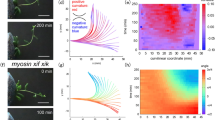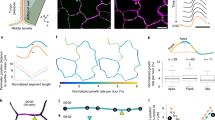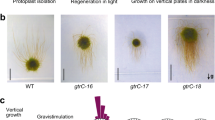Abstract
Plants are able to bend nearly every organ in response to environmental stimuli such as gravity and light1,2. After this first phase, the responses to stimuli are restrained by an independent mechanism, or even reversed, so that the organ will stop bending and attain its desired posture. This phenomenon of organ straightening has been called autotropism3 and autostraightening4 and modelled as proprioception5. However, the machinery that drives organ straightening and where it occurs are mostly unknown. Here, we show that the straightening of inflorescence stems is regulated by an actin–myosin XI cytoskeleton in specialized immature fibre cells that are parallel to the stem and encircle it in a thin band. Arabidopsis mutants defective in myosin XI (specifically XIf and XIk) or ACTIN8 exhibit hyperbending of stems in response to gravity, an effect independent of the physical properties of the shoots. The actin–myosin XI cytoskeleton enables organs to attain their new position more rapidly than would an oscillating series of diminishing overshoots in environmental stimuli. We propose that the long actin filaments in elongating fibre cells act as a bending tensile sensor to perceive the organ's posture and trigger the straightening system.
This is a preview of subscription content, access via your institution
Access options
Subscribe to this journal
Receive 12 digital issues and online access to articles
$119.00 per year
only $9.92 per issue
Buy this article
- Purchase on Springer Link
- Instant access to full article PDF
Prices may be subject to local taxes which are calculated during checkout




Similar content being viewed by others
References
Darwin, C. The Power of Movements in Plants (John Murray, 1880).
Gilroy, S. & Masson, P. H. Plant Tropisms (Blackwell, 2008).
Stankovic, B., Volkmann, D. & Sack, F. D. Autotropism, automorphogenesis, and gravity. Physiol. Plant. 102, 328–335 (1998).
Iino, M. Toward understanding the ecological functions of tropisms: interactions among and effects of light on tropisms. Curr. Opin. Plant Biol. 9, 89–93 (2006).
Bastien, R., Bohr, T., Moulia, B. & Douady, S. Unifying model of shoot gravitropism reveals proprioception as a central feature of posture control in plants. Proc. Natl Acad. Sci. USA 110, 755–760 (2013).
Shimmen, T. & Yokota, E. Cytoplasmic streaming in plants. Curr. Opin. Cell Biol. 16, 68–72 (2004).
Tominaga, M. & Nakano, A. Plant-specific myosin XI, a molecular perspective. Front. Plant Sci. 3, 211 (2012).
Ueda, H. et al. Myosin-dependent endoplasmic reticulum motility and F-actin organization in plant cells. Proc. Natl Acad. Sci. USA 107, 6894–6899 (2010).
Peremyslov, V. V., Prokhnevsky, A. I. & Dolja, V. V. Class XI myosins are required for development, cell expansion, and F-Actin organization in Arabidopsis. Plant Cell 22, 1883–1897 (2010).
Sparkes, I. A. Motoring around the plant cell: insights from plant myosins. Biochem. Soc. Trans. 38, 833–838 (2010).
Avisar, D., Abu-Abied, M., Belausov, E. & Sadot, E. Myosin XIK is a major player in cytoplasm dynamics and is regulated by two amino acids in its tail. J. Exp. Bot. 63, 241–249 (2012).
Tamura, K. et al. Myosin XI-i links the nuclear membrane to the cytoskeleton to control nuclear movement and shape in Arabidopsis. Curr. Biol. 23, 1776–1781 (2013).
Esmon, C. A. et al. A gradient of auxin and auxin-dependent transcription precedes tropic growth responses. Proc. Natl Acad. Sci. USA 103, 236–241 (2006).
Haga, K. & Iino, M. Asymmetric distribution of auxin correlates with gravitropism and phototropism but not with autostraightening (autotropism) in pea epicotyls. J. Exp. Bot. 57, 837–847 (2006).
Cai, C., Henty-Ridilla, J. L., Szymanski, D. B. & Staiger, C. J. Arabidopsis myosin XI: a motor rules the tracks. Plant Physiol. (2014).
Vidali, L. et al. Myosin XI is essential for tip growth in Physcomitrella patens. Plant Cell 22, 1868–1882 (2010).
Kandasamy, M. K., McKinney, E. C. & Meagher, R. B. A single vegetative actin isovariant overexpressed under the control of multiple regulatory sequences is sufficient for normal Arabidopsis development. Plant Cell 21, 701–718 (2009).
Lanza, M. et al. Role of actin cytoskeleton in brassinosteroid signaling and in its integration with the auxin response in plants. Dev. Cell 22, 1275–1285 (2012).
Kato, T., Morita, M. T. & Tasaka, M. Defects in dynamics and functions of actin filament in Arabidopsis caused by the dominant-negative actin fiz1-induced fragmentation of actin filament. Plant Cell Physiol. 51, 333–338 (2010).
Nakamura, M., Toyota, M., Tasaka, M. & Morita, M. T. An Arabidopsis E3 ligase, SHOOT GRAVITROPISM9, modulates the interaction between statoliths and F-actin in gravity sensing. Plant Cell 23, 1830–1848 (2011).
Blancaflor, E. B. Regulation of plant gravity sensing and signaling by the actin cytoskeleton. Am. J. Bot. 100, 143–152 (2013).
Fukaki, H. et al. Genetic evidence that the endodermis is essential for shoot gravitropism in Arabidopsis thaliana. Plant J. 14, 425–430 (1998).
Hashiguchi, Y., Tasaka, M. & Morita, M. T. Mechanism of higher plant gravity sensing. Am. J. Bot. 100, 91–100 (2013).
Blancaflor, E. B., Fasano, J. M. & Gilroy, S. Mapping the functional roles of cap cells in the response of Arabidopsis primary roots to gravity. Plant Physiol. 116, 213–222 (1998).
Hou, G., Mohamalawari, D. R. & Blancaflor, E. B. Enhanced gravitropism of roots with a disrupted cap actin cytoskeleton. Plant Physiol. 131, 1360–1373 (2003).
Yamamoto, K. & Kiss, J. Z. Disruption of the actin cytoskeleton results in the promotion of gravitropism in inflorescence stems and hypocotyls of Arabidopsis. Plant Physiol. 128, 669–681 (2002).
Palmieri, M. & Kiss, J. Z. Disruption of the F-actin cytoskeleton limits statolith movement in Arabidopsis hypocotyls. J. Exp. Bot. 56, 2539–2550 (2005).
Hou, G. et al. The promotion of gravitropism in Arabidopsis roots upon actin disruption is coupled with the extended alkalinization of the columella cytoplasm and a persistent lateral auxin gradient. Plant J. 39, 113–125 (2004).
Nakashima, J., Liao, F., Sparks, J. A., Tang, Y. & Blancaflor, E. B. The actin cytoskeleton is a suppressor of the endogenous skewing behaviour of Arabidopsis primary roots in microgravity. Plant Biol. (Stuttg.) 16(suppl. 1), 142–150 (2014).
Nakagawa, Y. et al. Arabidopsis plasma membrane protein crucial for Ca2+ influx and touch sensing in roots. Proc. Natl Acad. Sci. USA 104, 3639–3644 (2007).
Yamanaka, T. et al. MCA1 and MCA2 that mediate Ca2+ uptake have distinct and overlapping roles in Arabidopsis. Plant Physiol. 152, 1284–1296 (2010).
Hayakawa, K., Tatsumi, H. & Sokabe, M. Actin stress fibers transmit and focus force to activate mechanosensitive channels. J. Cell Sci. 121, 496–503 (2008).
Peremyslov, V. V., Prokhnevsky, A. I., Avisar, D. & Dolja, V. V. Two class XI myosins function in organelle trafficking and root hair development in Arabidopsis. Plant Physiol. 146, 1109–1116 (2008).
Nelson, B. K., Cai, X. & Nebenführ, A. A multicolored set of in vivo organelle markers for co-localization studies in Arabidopsis and other plants. Plant J. 51, 1126–1136 (2007).
Saito, C., Morita, M. T., Kato, T. & Tasaka, M. Amyloplasts and vacuolar membrane dynamics in the living graviperceptive cell of the Arabidopsis inflorescence stem. Plant Cell 17, 548–558 (2005).
Ye, Z. H., Freshour, G., Hahn, M. G., Burk, D. H. & Zhong, R. Vascular development in Arabidopsis. Int. Rev. Cytol. 220, 225–256 (2002).
Acknowledgements
We are grateful to Tobias Baskin (University of Massachusetts), Alistair M. Hetherington (University of Bristol) and James Raymond (Eigoken) for critical readings of this manuscript and to Moritoshi Iino (Osaka City University), Tomomi Suzuki (Kyoto University) and Akira Nagatani (Kyoto University) for helpful discussion. We are also grateful to Shoko Hongo (Tohoku University), Kazuhiko Nishitani (Tohoku University), Masatsugu Toyota (NAIST) and Masatoshi Taniguchi (NAIST) for their technical support; to Valerian V. Dolja (Oregon State University) for his donation of the ProXIk:XIk–YFP construct, transgenic seeds and anti-XIk antibody; to Takashi Ueda (University of Tokyo) for his donation of the Pro35S:Lifeact–Venus construct; to Tsuyoshi Nakagawa (Shimane University) for his donation of Gateway vectors; and to the ABRC for providing seeds of A. thaliana tDNA insertion mutants. This work was supported by Specially Promoted Research of Grant-in-Aid for Scientific Research to I.H-N. (no. 22000014), Grants-in-Aid for Scientific Research to K.O. (no. 23.2) and to H.U. (nos. 21200065 and 25440132) from the Japan Society for the Promotion of Science (JSPS).
Author information
Authors and Affiliations
Contributions
K.O., H.U., T.S. and I.H-N. conceived the study; K.O. and H.U. designed the experiments; K.O. generated myosin mutants and analysed tropic responses. K.O. and H.U. generated transgenic plants and analysed straightening; K.O., T.K., M.T. and M.T.M. analysed gravitropic responses; K.O., H.U., T.S., K.T. and I.H-N. participated in discussion; K.O., H.U., T.S. and I.H-N. wrote the manuscript.
Corresponding author
Ethics declarations
Competing interests
The authors declare no competing financial interests.
Rights and permissions
About this article
Cite this article
Okamoto, K., Ueda, H., Shimada, T. et al. Regulation of organ straightening and plant posture by an actin–myosin XI cytoskeleton. Nature Plants 1, 15031 (2015). https://doi.org/10.1038/nplants.2015.31
Received:
Accepted:
Published:
DOI: https://doi.org/10.1038/nplants.2015.31
This article is cited by
-
Shoot gravitropism and organ straightening cooperate to arrive at a mechanically favorable shape in Arabidopsis
Scientific Reports (2023)
-
Space–time analysis of gravitropism in etiolated Arabidopsis hypocotyls using bioluminescence imaging of the IAA19 promoter fusion with a destabilized luciferase reporter
Journal of Plant Research (2017)



